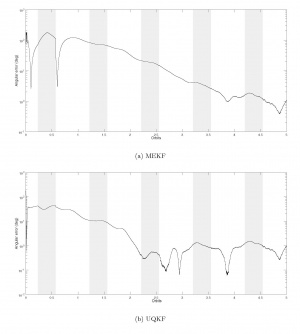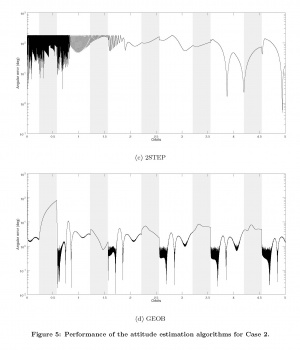An Accurate, Inexpensive Attitude Determination and Control System for CubeSats by Duarte Rondão, Cass Hussmann and Afzal Suleman Part 7
From The Space Library
Contents |
VII. Conclusions
The analysis in Section VI show that MEKF’s renown is hard to beat. The filter presents the best overall performance, along with UQKF. It is bested only by 2STEP in some particular points of the orbit. However, the lack of robustness of 2STEP in the presence of large initial errors and its huge computational effort do not make it a superior choice. Additionally, MEKF is the computationally lightest of the four algorithms apart from GEOB. It was found that MEKF had trouble converging from large attitude and bias error estimates. To this end, a hybrid algorithm was devised which initializes the attitude acquisition with GEOB and then switches to MEKF for the rest of the mission. The hybrid algorithm is capable of almost instantaneously converge from very large initial error estimates and of maintaining a nominal accuracy of approximately 1.5 deg during eclipse and up to a tenth of degree outside, which is very much in-line with the pointing budget goal of 4.78 deg. This was achieved with an attitude sensing suite which represents only 4% of the estimated overall cost of the project.
To the present date, the attitude controller has not yet been successfully implemented. The small size of the RWS cause a very fast momentum build-up originating from the torque required by the controller, leading to the almost immediate saturation of one or more reaction wheels. It might be the case that the momentum unloading law of Eq. (IV.5) is not appropriate given the system dimension, and different laws for this purpose may have to be investigated. A strategy to divide the total required command torque between the RWS and the magnetorquers might also prove useful to help solve the problem.
VIII. Future Work
The attitude estimation for ECOSat-III achieved great results given uncalibrated sensor hardware for a worst-case scenario. The next step in AD testing is to acquire the sensors, characterize and calibrate them in a laboratory environment in order to update the sensor models in the simulations. It is foreseen that, if the sensors are properly calibrated, an improvement of an order of magnitude in the estimation accuracy can be achieved. This work assumes that, provided the satellite is outside of eclipse, a sun sensor measurement is always obtainable. Realistically, this is not always the case, as ECOSat-III only features a single sun sensor mounted on one of its faces. An installation of less accurate (but cheaper) photodiodes on each of the remaining faces can be made to provide precise enough measurements to be able to place the sun vector in the field-of-view of the sun sensor. Additionally, a full replacement of the sun sensor with 6 photodiodes may be investigated, as there is enough margin in the estimation accuracy obtained with this work for it. After the AC algorithms are sucessfully implemented an tested, further progress can be made in deriving algorithms for the ground station targeting and safe modes.
Figure 5: Performance of the attitude estimation algorithms for Case 2.
Figure 6: Performance of the GEOB+MEKF hybrid attitude estimation algorithm Case 3.
Acknowledgements
This research was supported by the Centre for Aerospace Research (CfAR) of the University of Victoria. The authors thank their colleagues from CfAR and the UVIC ECOSat team who provided insight and expertise that greatly assisted the research, in particular Peter Kazakoff for his knowledge of the orbital simulator used in the numerical analysis, Danielle McLean for her work on the magnetorquer design and Ricardo Gomes for the RWS design. The authors would also like to thank Mr. Alireza Khosravian of the Australian National University Research School of Engineering for assistance with the GEOB algorithm, which greatly improved the manuscript.
References
[1] Markley, F. L. and Crassidis, J. L., Fundamentals of Spacecraft Attitude Determination and Control, Vol. 33, Springer, 2014.
[2] Wertz, J. R., “Spacecraft Attitude Determination and Control,” Astrophysics and Space Science Li¬brary, Vol. 73, 1978.
[3] Breckenridge, W., “Quaternions proposed standard conventions,” Jet Propulsion Laboratory, Pasadena, CA, Interoffice Memorandum IOM , 1999, pp. 343–79.
[4] Shuster, M. D., “A survey of attitude representations,” Navigation, Vol. 8, No. 9, 1993, pp. 439–517.
[5] Markley, F. L., Crassidis, J. L., and Cheng, Y., “Nonlinear attitude filtering methods,” AIAA Guidance, Navigation, and Control Conference, 2005, pp. 15–18.
[6] Farrenkopf, R., “Analytic steady-state accuracy solutions for two common spacecraft attitude estima¬tors,” Journal of Guidance, Control, and Dynamics, Vol. 1, No. 4, 1978, pp. 282–284.
[7] Lefferts, E. J., Markley, F. L., and Shuster, M. D., “Kalman filtering for spacecraft attitude estimation,” Journal of Guidance, Control, and Dynamics, Vol. 5, No. 5, 1982, pp. 417–429.
[8] Crassidis, J. L. and Markley, F. L., “Unscented filtering for spacecraft attitude estimation,” Journal of guidance, control, and dynamics, Vol. 26, No. 4, 2003, pp. 536–542.
[9] Kasdin, N. J. and Weaver, T. J., “Recursive satellite attitude estimation with the two-step optimal estimator,” presented as paper AIAA, Vol. 4462, 2002, pp. 5–8.
[10] Mahony, R., Hamel, T., and Pflimlin, J.-M., “Nonlinear complementary filters on the special orthogonal group,” Automatic Control, IEEE Transactions on, Vol. 53, No. 5, 2008, pp. 1203–1218.
[11] Khosravian, A. and Namvar, M., “Globally exponential estimation of satellite attitude using a single vector measurement and gyro,” Decision and Control (CDC), 2010 49th IEEE Conference on, IEEE, 2010, pp. 364–369.
[12] Stickler, A. C. and Alfriend, K., “Elementary magnetic attitude control system,” Journal of spacecraft and rockets, Vol. 13, No. 5, 1976, pp. 282–287.
[13] Avanzini, G. and Giulietti, F., “Magnetic detumbling of a rigid spacecraft,” Journal of guidance, control, and dynamics, Vol. 35, No. 4, 2012, pp. 1326–1334.
[14] Crassidis, J. L., Vadali, S. R., and Markley, F. L., “Optimal variable-structure control tracking of spacecraft maneuvers,” Journal of Guidance, Control, and Dynamics, Vol. 23, No. 3, 2000, pp. 564–566.
[15] Camillo, P. J. and Markley, F., “Orbit-averaged behavior of magnetic control laws for momentum unloading,” Journal of Guidance, Control, and Dynamics, Vol. 3, No. 6, 1980, pp. 563–568.
[16] Armenise, M. N., Ciminelli, C., Dell’Olio, F., and Passaro, V. M., Advances in gyroscope technologies, Springer Science & Business Media, 2010.
[17] McLean, D., “Magnetorquer Design,” Tech. rep., University of Victoria, Centre for Aerospace Research, May 2014.
[18] Gomes, R., “Development of a reliable and low-cost miniaturized reaction wheel system for CubeSat applications,” Canadian Space Summit, 2015.



